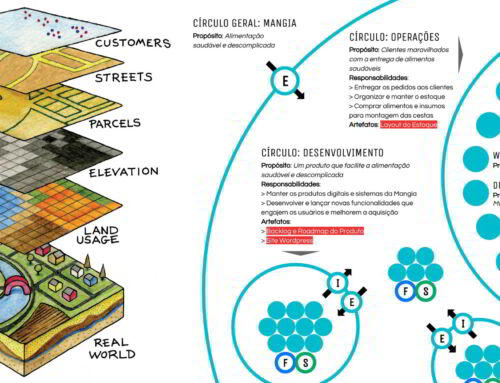I know, you need to find a scalable business model. Fast.
But that’s what all startups already know.
What they do not know, or know but do not pay attention to, is that the way we organize strongly influences the results we get. And what we will be in the future.
Consider for a moment your organizational structure. Is it like this?

Why?
You may not know the answer. But I would argue that you have this structure because this is the way we have organized companies since ever. And few reflect on it.
The hierarchy, the chain of command and schemes of approval. Everything needs to be authorized.
It destroys innovation, motivation, collaboration, thought out of the box. It is static and does not like change.
Embracing change should be at the heart of your startup. After all, the market changes. Competitors change. You need to pivot. The crisis is coming. Your organization needs to change.
But the pyramid is slow and domineering. The egos come into play and can kill the initiatives. How will your Head of Design understand that a restructuring is now needed and that the designers who used to be underneath it need to go to the product team? It will not be easy.
Okay, but what’s the alternative?
There is something else. It’s called self-organization:

You have seen that already.
It is present in nature. The human body works like this. Agile software development teams are accustomed to working this way.
Collaboration, decentralization, servant leadership and facilitation. The system guarantees the organization without the need for an approving power.
But as your business grows, a greater amount of structure and processes is needed to maintain alignment. The hierarchy takes over and collaboration gives way to command and control.
Goodbye, agile teams. Goodbye, innovation.
Goodbye, startup. Hello, corporation.
The way you organize says a lot about you
Your startup grows, you hire a COO, a CTO, a CIO, a CPO, a CMO, a CFO, a CXYZ. And heads. Lots of area heads. People you trust and will keep things “on the rails”.
Really?
The hierarchical pyramid is great at controlling people and keeping things “static”. But in today’s times, you want everyone to collaborate and use their brilliant minds to innovate and generate value. You want adaptability.
The problem is that it is difficult to innovate with a boss controlling your life and approving everything you do. Blocking communication and protecting your area from the rest of the organization. It becomes a war of power, each department defending its side. Without realizing that everyone should be working towards the same goal.
Want to become a big corporation? Keep it up.
Want to keep the young, innovative and disruptive mood of a startup? Embrace new models of management and organization.
The Responsive Organizations are here
There is a new movement coming. It is called “Responsible Organizations”. And they came to transform the world of work. They are walking farther to the right side:
Profit => Purpose
Controlling => Empowering
Planning => Experimentation
Hierarchies => Networks
Privacy => Transparency
Understood. But how do I start?
1) Stop working with anyone who just wants money and start working with those who believe in your product (and purpose)
Money-oriented people seek shorter paths to meet their individual needs, sacrificing the long term (and the organization). These really need to be supervised. Get away from them.
Look for those who connect with your idea and who like what they do. It is called intrinsic motivation. Generation Y fits well in this profile.
Note: Just because they are not there for the money does not mean you should not pay them properly.
2) Create an adaptive, self-organized organizational structure
Bright people do not like to be controlled. To maintain them, you must invest in adaptive structures that foster innovation. There are several ways to do this. From the Spotify model to Holacracy. Seek to understand what makes the most sense for your context and experiment.
Avoid becoming one more big, bureaucratic and slow corporation by working with passionate people. Rely on intrinsic motivation and self-organized structures. If you need help, just tell us your story so we can help you. ;)






[…] we said in the post “Goodbye, startup, Hello corporation”, it is very likely that your company is still stuck in the same organizational structure of the […]